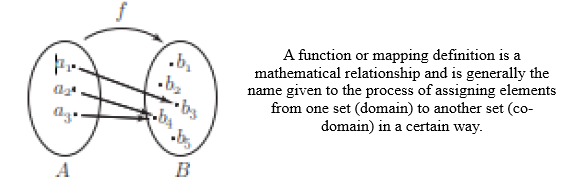2.2.1. The Concept of Function or Mapping

A function is a relation that associates each element of a set A (commonly called the input or argument) with exactly one element (commonly called the output or image). That is, a function is defined as 𝒇∶𝑨−→𝑩.
Here:
- The set A is called the domain (input set),
- The set B is called the codomain.
The function assigns a unique f(x) ∈ B to each element x ∈ A. This means that each element of set A is mapped to exactly one element of set B. However, multiple elements from set A can be mapped to the same element in set B, but no element of set B can be assigned more than once from set A.
2.2.2. Onto Definition
The onto definition can also be expressed as surjective. A function is called an onto function or surjective function if, after mapping the elements of the domain to the elements of the codomain, no element in the codomain is left without a corresponding element. In other words, in an onto function, every element of the codomain is the image of at least one element from the domain. Here, the term “domain” refers to the domain set, and “codomain” refers to the codomain set.
2.2.3. Injective Function Definition
If each element in the range is mapped by exactly one element from the domain, then the function is called one-to-one or injective. If a function is not one-to-one, it is called many-to-one.
NOT!
- In the case of a one-to-one correspondence (or injective function), each element of set A corresponds to a distinct element of set B, and no element of set B is mapped by more than one element of set A. A one-to-one correspondence is a relation in which each element has only one match.
- In the case of surjectivity (onto function), each element of set A must map to every element of set B at least once. However, multiple elements from set A can be mapped to the same element of set B. That is, some elements of set B can correspond to more than one element of set A.
2.2.4. Bijective Function Definition
For a function to be bijective, it must be both surjective (onto) and injective (one-to-one). This means the following:
- Since it is surjective (onto), every element in the codomain is mapped by an element from the domain. In other words, all elements of the codomain are matched.
- Since it is injective (one-to-one), every element in the domain is mapped to exactly one element in the codomain, and no element of the codomain is mapped by more than one element of the domain.
A bijective function establishes a one-to-one correspondence between the elements of set A and the elements of set B. That is, each element of set A corresponds to a distinct element in set B, and vice versa. This means there is a perfect matching between the two sets.
Bijective Functions and Quantum Computing: Bijective functions play an important role in defining structures such as reversible digital and quantum gates. These gates are used in quantum information processing, and their reversibility depends on their bijectiveness.
Boolean Functions and Quantum Computing: Boolean functions are functions where both the domain and codomain values consist of binary digits (0 and 1). These types of functions are particularly important in quantum computing studies, as information in quantum computing is typically processed through binary systems, and Boolean functions serve as fundamental building blocks for such computations.
In summary, bijective functions must be both surjective and injective, representing a perfect matching between two sets. These functions play a crucial role in defining reversible gates in quantum computing.